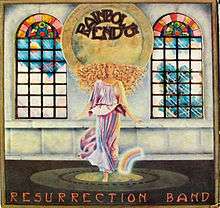Rainbow's End (album)
| Rainbow's End | ||||
|---|---|---|---|---|
|
| ||||
| Studio album by Resurrection Band | ||||
| Released | 1979 | |||
| Recorded |
Pumpkin Studios, Chicago, Illinois, 1979 | |||
| Genre | Christian rock | |||
| Length | 36:23 | |||
| Label | Star Song | |||
| Producer | Resurrection Band | |||
| Resurrection Band chronology | ||||
| ||||
| Alternative cover | ||||
 Alternative cover art with the inner sleeve reversed |
||||
| Professional ratings | |
|---|---|
| Review scores | |
| Source | Rating |
| CCM Magazine | (?) [1] |
| Firestream | |
Rainbow's End is the second full-length album by American Christian rock band Resurrection Band, released in 1979.
Recording history
Resurrection Band continues in its Led Zeppelin-inspired rock vein with this record.[1] This release is significant for the inclusion of "Afrikaans," the first anti-apartheid song ever released by an American rock band, one full year before Peter Gabriel brought the issue to listeners' attention with "Biko." Although the band was greatly pleased with this album, that sentiment was not shared by the record label, and Rainbow's End would be the band's last release for Star Song.
Track listing
| No. | Title | Writer(s) | Length |
|---|---|---|---|
| 1. | "Midnight Son" | Glenn Kaiser | 3:23 |
| 2. | "Strongman" | Tom Cameron, Stu Heiss, Kaiser, Jon Trott | 3:18 |
| 3. | "Afrikaans" | Kaiser | 3:35 |
| 4. | "Skyline" | Cameron, Jim Denton, Kaiser | 3:11 |
| 5. | "Paint a Picture" | Heiss, Kaiser | 4:53 |
| 6. | "Rainbow's End" | Cameron, Denton, Heiss, Kaiser, John Herrin | 3:49 |
| 7. | "Concert for a Queen" | Kaiser | 3:17 |
| 8. | "Sacrifice of Love" | Kaiser | 3:04 |
| 9. | "The Wolfsong" | Heiss, Kaiser | 3:14 |
| 10. | "Everytime It Rains" | Denton, Kaiser | 4:48 |
| Total length: | 36:30 | ||
The title track was never played live until Resurrection Band's final concert at the Cornerstone Festival in 2000.
Personnel
- Glenn Kaiser - Lead and background vocals, electric guitars
- Wendi Kaiser - Lead and background vocals
- Stu Heiss - Electric and acoustic guitars, piano, organ, Moog synthesizer, "Heiss Box" guitar synthesizer
- Jim Denton - Bass guitar, acoustic guitar
- John Herrin - Drums
- Roger Heiss - Percussion
- Tom Cameron - Harmonica
- Kenny Soderblom - Saxophone, recorder
Production
- Producer - Resurrection Band
- Engineers - Gary Loizzo, Stu Heiss and Roger Heiss
- Mixers - Stu Heiss and Resurrection Band
Album Design
The gatefold LP for Rainbow's End originally came in a slipcase cover with die-cut windows on either side of the angel. Depending on which side was inserted, the windows revealed either heavenly clouds (as seen at left), or stained-glass windows (as seen in the album infobox above).